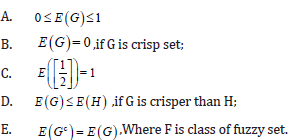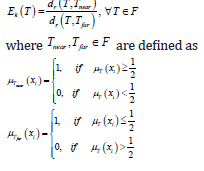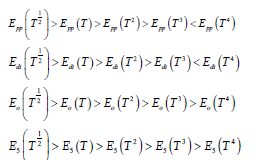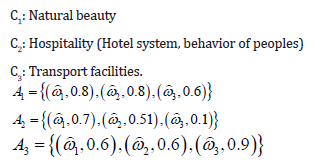- Submissions

Full Text
Research & Development in Material Science
Selection of Best Tourist Place in Gilgit Baltistan, Pakistan using New Entropy Measure of Fuzzy Set with F-TOPSIS
Muhammad Kabeer1, Zahid Hussain1 and Sahar Abbas1,2*
1Department of Mathematical Science, Karakoram International University, Gilgit-Baltistan, Pakistan
2Institute of Business Administration, Karachi, Pakistan
*Corresponding author: Sahar Abbas, Department of Mathematical Science, Karakoram International University, Gilgit-Baltistan, Pakistan.Institute of Business Administration, Karachi, Pakistan
Submission: February 06, 2023;Published: March 15, 2023

ISSN: 2576-8840 Volume 18 Issue 3
Abstract
Fuzzy Sets (FSs) are important tool to model uncertainty and vagueness. Entropy is being used to measure the fuzziness within in a Fuzzy Set (FS). We suggested new entropy measure for FSs. The suggested entropy is provided to satisfy all the axioms. The numerical results show that the newly proposed entropy can be computed easily and give reliable results. The decision-making algorithm F-TOPSIS (Techniques of ordered preference similarity to ideal solution) is utilized to solve Multicriteria Decision-Making Problem (MCDM) related to daily life. These entropy measures are applied for ranking the best tourist place at Gilgit Baltistan (GB) Pakistan. Numerical examples with applications show practical effectiveness of our proposed entropy measure.
Keywords:Fuzzy entropy; Uncertainty; TOPSIS; Multi criteria decision making
Introduction
The precision of mathematics has indebted its achievement in huge measures to the applications of Aristotle and the philosophers who lead him. In their exertions to formulate a brief theory of logic, the so-called “Laws of Thought” introduced. After that, the “Law of the Excluded Middle”, and the conditions that “each proposition necessity can also be True or False”. After two-way logic, three-way logic, four-way logic and nth way logic were introduced. The theory of fuzzy is generalization of crisp set which is infinite way logic. Zadeh [1] first time introduce the fuzzy set theory. The acknowledgement of fuzzy set theory raised up steadily in the 1960s and 1970s [1-3]. Crisp set theory is not able to define clearly vague and imprecise information. There are many problems related to vague and imprecise in daily life, two-way logic and set theory is unable to manage such types of problems. Thus, fuzzy set theory can define vague and imprecise information easily. Fuzzy set theory is used in image processing, pattern recognition, optimization etc. [4,5]. Many researchers work on distances of Fuzzy Sets (FSs). In 1999, Rosenfeld [6] published a paper about a adapted Harsdorf distance between fuzzy sets and proposed modified metric which comprises a single word expressive geometric distance. Zhang & Zhang [7] proposed hybrid monotonic inclusion measure and its use in measuring similarity and distance between fuzzy sets. L Son [8] published a paper about generalized picture distance and measure and applications to picture fuzzy clustering
According to Shannon [3] entropy is the measure of disorder and attempts to explain the quantity of important in truths set and predictability. Boltzmann [9] explain the idea of entropy as a measure of the irregularity of ideal gas in a sealed flask. On other side the information theory rose through the dedication of problems connecting to telecommunications. Non-probabilistic entropy of Fuzzy Sets (FSs) was introduced by De Luca & Termini [10]. They accomplish that Shannon probabilistic entropy is use for accurate purpose in special case. The concept of credibility measure and give the necessary and sufficient condition for credibility measure was introduced by Lee [11] and refined Li & Liu [12]. Yager [13] suggested novel entropy based on distances of fuzzy set. Hwang & Yang [14] proposed new entropy of fuzzy sets and compare it with several existing one. Yang’s proposed entropy is based on exponential function. Ebanks [15] proposed some properties for an entropy of FSs. Higashi [16] prolonged Yager’s measure to a universal class of fuzzy complements. Kosko [17] providing a measure of fuzziness between fuzzy sets using a ratio of distance between the fuzzy set and its adjacent set to the distance between the fuzzy set and its furthest set. Fan et al. [18] proposed some fuzzy entropy formulas. More surveys on measuring fuzziness were given by Pal and Pal [19] and Pal and Bezdek [20]. Recently Hussain et al. [21] and Sharif et al. [22] proposed new entropy of fuzzy sets and its applications to multicriteria decision making with fuzzy TOPSIS. In this literature we discuss about tourism in GB, because tourism is big source of income in Gilgit Baltistan. Many articles were published about tourism development in GB [23-26]. Now we use novel entropy measure of fuzzy techniques and select the best tourism place.
Finally, we introduced our new entropy on the base of Yang’s Hwang & Yang [14] proposed entropy and compare with the help of table. Yang’s proposed entropy and our new entropy give us best result. The rest of the paper is outlined as follows. In section 2, we review already existing entropy measures of a fuzzy set and suggest a new entropy of a fuzzy set. In section 3, we display some numerical examples and compare with Yang’s [14] proposed entropy and used linguistic variables to authenticate our proposed method. In section 4, fuzzy TOPISIS method is used for multicriteria decision making and applies it to select the best district selection for tourist in Gilgit Baltistan (GB). Finally, the conclusion is stated in section 5.
Preliminaries
This section includes the review of basic notions and crisp sets, fuzzy sets, entropy of fuzzy sets and some proposed fuzzy entropy measure respectively as follows.
Definition 1 [24]: Let X be a universal set and P ⊆ X be nonempty set and membership function for crisp set and ∀x∈ X is define as

In other words, we can says that the membership degree of μP(xi)is only 0 or 1 and we can says “yes” if membership degree is 1 and “No” if the membership degree is 0 such that

Definition 2 [1]: The membership function of fuzzy set is mapped to real numbers between 0 and 1 such that

Definition 3 [24]: We can write Fuzzy sets in the power of sets. The second power of fuzzy set P and we let S be universal set is defined by the following notion.

Likewise, we represent the mth power of fuzzy set Pm can be written as,

Definition 4 [18]: The function E : F →[0,1] is entropy of F, if E has following properties:

Yager [13] suggest new fuzzy entropy based on distance of fuzzy sets. When we minus one to any distance we find entropy and is define as

Kosko [17] define the fuzzy entropy as distance to near and far sets.

Pal and Pal [19] define entropy exponential entropy as

De Luca and Termini [10] give the formula for entropy as

The Hwang & Yang [14] proposed entropy and defined as

Our proposed entropy of FSs is define as

Result and Discussion
The entropy of fuzzy set must follow the fallowing pattern according to Hwang & Yang [14],

Thus entropy measure is in fractional form it must be satisfy the above pattern.
Example 1: Let us consider a fuzzy set


We put all the entropies in the Table 1 and compare them after compare we are capable to say which entropy is finest. Subsequently assembling the table and situate different entropies in the table the outcomes are like this. The comparison of all the entropies are put in the Table 1 and the results are given below:


Table 1:Comparison of entropy measures of FSs.

Now it is clear from the Table 1 and comparison that the Hwang and Yang’s [14] proposed entropy and our new entropy give us better result rather than all others entropy measures. Thus, we can say that the yang’s entropy and our suggest entropy is best and functional for degree of fuzziness of fuzzy sets.
Construction of TOPOSIS based on entropy
There are many methods for decision making like VIKOR, TOPSIS etc. Now, I offered the TOPSIS method for Multicriteria Decision Making (MCDM). The TOPSIS method gives solid result in the decision making process and simplest steps are used for decision making. Decision making is important portion of up-todate management. Decision making is the procedure of choosing the preeminent choice from obtainable determinate quantity of possible choices [27]. In our everyday life, it is the communal action that frequently happens and shows vital part in variation of arenas like, compute science, finance, and political sciences etc. Multicriteria Decision Making (MCDM) is a procedure to choose an optimum choice from a determinate quantity of viable options or the substitutions in favorite command under numerous criteria [28]. Fuzzy entropy is a dominant implement to explain decisionmaking problems involving uncertain or vague evidence with high accuracy. In this section, we relate the suggested entropy measures of fuzzy set for MCDM hitches. We spread the method for instruction favorite by similarity measure to an perfect solution (TOPSIS) method by assembling a new fuzzy entropy TOPSIS to explain MCDM hitches based on Yang’s suggested entropy and our new entropy measures of FSs. In actual venue with decision-making procedure, evidence accessible is frequently inexact, unclear, or rough. Fuzzy Set is a prevailing implement to explain decisionmaking problems relating inexact, unclear, or loose evidence with extraordinary accuracy. We apply the Yang’s suggested entropy and our new entropy of fuzzy set for MCDM in this section [29].
We spread the procedure for order partiality by similarity to the perfect solution (TOPSIS) by assembling a novel fuzzy TOPSIS to resolve MCDM problems centered by the Yang’s proposed entropy and our new one measures. MCDM problems can be defined on the set of alternatives. By using these alternatives decision makers can easily select the batter alternative, under certain criteria which can be set by decision makers. Let us assume there are set of an alternatives A={A1,A2,A3,...,Ai} the set consist of alternatives. Amongst all these alternatives decision makers choice the finest alternative or select rendering to favorite mandate from upstairs set A rendering to set of criteria C={C1,C2,...,Cj} Let us assume that M=(μij)mxn is the fuzzy decision matrix, where i, j =1,2,3,...,m are fuzzy sets that represent all probable valuation values by decision makers, in which the alternative i A satisfies the criteria Cj . Let all criteria C={C1,C2,...,Cj} be of the same type, therefore no need with organization. The steps for TOPSIS are as under;
Step1: In this step, we construct the fuzzy decision matrix M=(μij)mxn is constructed. Here μij represent the fuzzy set that signifies all possible estimate which are given by decision makers thus the alternative i A satisfies the criteria j C .

Step2: Construction of weight criteria.
The unknown weights are found in this step by using the fallowing formula;

Step 3: Fuzzy Positive Ideal Solution (FPIS) and Fuzzy Negative Ideal Solution (FNIS).
In the method of TOPSIS, the estimation criteria can be categorized into two groups which are cost and benefit criteria. Suppose that 1 R is a collecting of benefit criteria and 2 R is a collecting of cost criteria. By the definition of fuzzy set theory we define the FPIS) F+ and FNIS F− as follows:

Step4 Construction of the distance on alternative to FPIS and FNIS.
We use the weighted Hamming distance to find distance of each alternatives to FPIS and FNIS as fallow.

Step5: Construction of degree of the relative closeness
The comparative familiarity degree G(Ai) of each alternative with reverence to fuzzy ideal solutions is calculated as follows:

Step 6. Raking order for each alternative.
We select the greater value of G(Ai) is consider as better alternative Ai . Thus, one can choice the appropriate alternative, in accordance with a descending order of the overall values of all the alternatives.
Example 2: Suppose that we want to select the best tourist place at GB. The alternatives are A1,A2,A3. Assumes that three criteria C1,C2,C3 are stated as follows:

Step 1: Fuzzy decision metric
Step 2: Criteria Weights
Step 3,4,5: Distance of each alternative with FPIS, FNIS and relative closeness
Step 6: Ranking order alternatives (Table 2-5)
Thus the ranking order of our new entropy and Yang’s proposed entropy measures are same. It is clear that the ranking order of Table 6 according to fuzzy entropy. The alternative A1 is greater than other alternatives. So the alternative A1 is best tourist place GB [30-33].
Table 2:Fuzzy decision matrix.

Table 3:calculation of weigh criteria.

Table 4:Relative closeness for Ehy (A)..

Table 5:Relative closeness for E5 (A)..

Table 6:Ranking order alternatives.

Conclusion
Fuzzy sets play an important role in solving MCDM problems. In this manuscript, we have suggested novel fuzzy entropy and perform comparison analysis with Hwang and Yang’s [14] proposed entropy measure for FSs. The results derived from Hwang and Yang’s [14] proposed entropy and our new proposed one give healthier results rather than other existing entropy measures which shows the efficiency of our proposed entropy. We also paradigm a TOPSIS for MCDM and used it to practical example to show the strength, correctness and efficiency of fuzzy TOPSIS in MCDM, to demonstration of the reimbursements of our recommended procedure. Finally, our entropy and Yang’s entropy of FSs is useful in an application to MCDM for ranking the best tourist place in GB. Based on acquired consequences, we accomplish that our proposed entropy of FSs is equitable and healthy in management different categories of daily life problems.
References
- Zadeh LA (1965) Information and control. Fuzzy sets 8(3): 338-353.
- Shannon CE (1948) A mathematical theory of communication. The Bell System Technical Journal 27(3): 379-423.
- Xuecheng L (1992) Entropy distance measure and similarity measure of fuzzy sets and their relations. Fuzzy Sets and Systems 52(3): 305-318.
- Horvath J (2006) Image segmentation using fuzzy c-means, pp. 792-795.
- Wang C, Pedrycz W, Li Z, Zhou M, Zhao J (2020) Residual-sparse fuzzy C-means clustering incorporating morphological reconstruction and wavelet frame. IEEE Transactions on Fuzzy Systems 29(12): 3910-3924.
- Chaudhuri BB, Rosenfeld A (1999) A modified Hausdorff distance between fuzzy sets. Information Sciences 118(1-4): 159-171.
- Zhang HY, Zhang WX (2009) Hybrid monotonic inclusion measure and its use in measuring similarity and distance between fuzzy sets. Fuzzy Sets and Systems 160(1): 107-118.
- Son LH (2016) Generalized picture distance measure and applications to picture fuzzy clustering. Applied Soft Computing 46(C): 284-295.
- Tsallis C (2019) Beyond Boltzmann-Gibbs-Shannon in physics and elsewhere. Entropy 21(7): 696.
- De Luca A, Termini S (1972) A definition of a non-probabilistic entropy in the setting of fuzzy sets theory. Information and Control 20(4): 301-312.
- Lee KH (2005) First course on fuzzy theory and applications 27: 253-283.
- Li P, Liu B (2008) Entropy of credibility distributions for fuzzy variables. IEEE Transactions on Fuzzy Systems 16(1): 123-129.
- Yager RR (1979) On the measure of fuzziness and negation Part I: Membership in the unit interval. Int J of General System 5(4): 221-229.
- Hwang CM, Yang MS (2008) On entropy of fuzzy sets. International Journal of Uncertainty, Fuzziness and Knowledge-Based Systems 16(4): 519-527.
- Ebanks BR (1983) On measures of fuzziness and their representations. Journal of Mathematical Analysis and Applications 94(1): 24-37.
- Higashi M (1982) On measure of fuzziness and fuzzy complements. Int Journal of General Systems 8(3): 169-180.
- Kosko B (1986) Fuzzy entropy and conditioning. Information Sciences 40(2): 165-174.
- Fan J, Xie W (1999) Distance measure and induced fuzzy entropy. Fuzzy Sets and Systems 104(2): 305-314.
- Pal NR, Pal SK (1992) Some properties of exponential entropy. Information Sciences 66(2): 119-137.
- Pal NR, Bezdek JC (1994) Measuring fuzzy uncertainty. IEEE Transactions on Fuzzy Systems 2(2): 107-118.
- Hussain M, Hussain Z, Sharif R, Abbas S (2021) Novel fuzzy entropy and its applications to multicriteria decision making with fuzzy topsis. Journal of Mechanics of Continua and Mathematical Sciences 16: 1-13.
- Sharif R, Hussain Z, Hussain S, Abbas S, Hussain I (2021) A novel fuzzy entropy and its applications in covid-19 with fuzzy topsis. Journal of Mechanics of Continua and Mathematical Sciences 16(6): 52-63.
- Ahmad S (2016) Tourism in Pakistan: Challenges, prospects and potential of Gilgit-Baltistan. Pakistan Perspective 21(2).
- Baig S, Hussain H (2020) Do shocks have permanent or transitory effects on tourist inflow? An application of stationarity test with structural breaks: evidence reexamined for Gilgit-Baltistan, Pakistan. Asia Pacific Journal of Tourism Research 25(2): 120-130.
- Hussain A, Fisher D, Espiner S (2017) Transport infrastructure and social inclusion: A case study of tourism in the region of Gilgit-Baltistan. Social Inclusion 5(4): 196-208.
- Khan K (2012) Tourism downfall: Sectarianism an apparent major cause, in Gilgit-Baltistan (GB), Pakistan. Journal of Political Studies 9(2): 155-168.
- Cheng HD, Chen YH, Sun Y (1999) A novel fuzzy entropy approach to image enhancement and thresholding. Signal Processing 75(3): 277-301.
- Dubois DJ (1980) Fuzzy sets and systems. Theory and applications. Academic Press, pp. 144: 1-393.
- Dzitac I, Filip FG, Manolescu MJ (2017) Fuzzy logic is not fuzzy: World-renowned computer scientist Lotfi A. Zadeh. International Journal of Computers Communications & Control 12(6): 748-789.
- Hussain Z, Yang MS (2018) Entropy for hesitant fuzzy sets based on hausdorff metric with construction of hesitant fuzzy TOPSIS. International Journal of Fuzzy Systems 20(8): 2517-2533.
- Malone D, Sullivan W (2005) Guesswork is not a substitute for entropy, pp. 1-5
- Si L, Wang Z, Liu X, Tan C (2019) A sensing identification method for shearer cutting state based on modified multi-scale fuzzy entropy and support vector machine. Engineering Applications of Artificial Intelligence 78: 86-101.
- Zimmermann HJ (2011) Fuzzy set theory and its applications. (4th edn), Springer Science & Business Media, Kluwer Academic Publishers, USA.
© 2023 Sahar Abbas. This is an open access article distributed under the terms of the Creative Commons Attribution License , which permits unrestricted use, distribution, and build upon your work non-commercially.
 a Creative Commons Attribution 4.0 International License. Based on a work at www.crimsonpublishers.com.
Best viewed in
a Creative Commons Attribution 4.0 International License. Based on a work at www.crimsonpublishers.com.
Best viewed in 







.jpg)






























 Editorial Board Registrations
Editorial Board Registrations Submit your Article
Submit your Article Refer a Friend
Refer a Friend Advertise With Us
Advertise With Us
.jpg)






.jpg)














.bmp)
.jpg)
.png)
.jpg)










.jpg)






.png)

.png)



.png)






